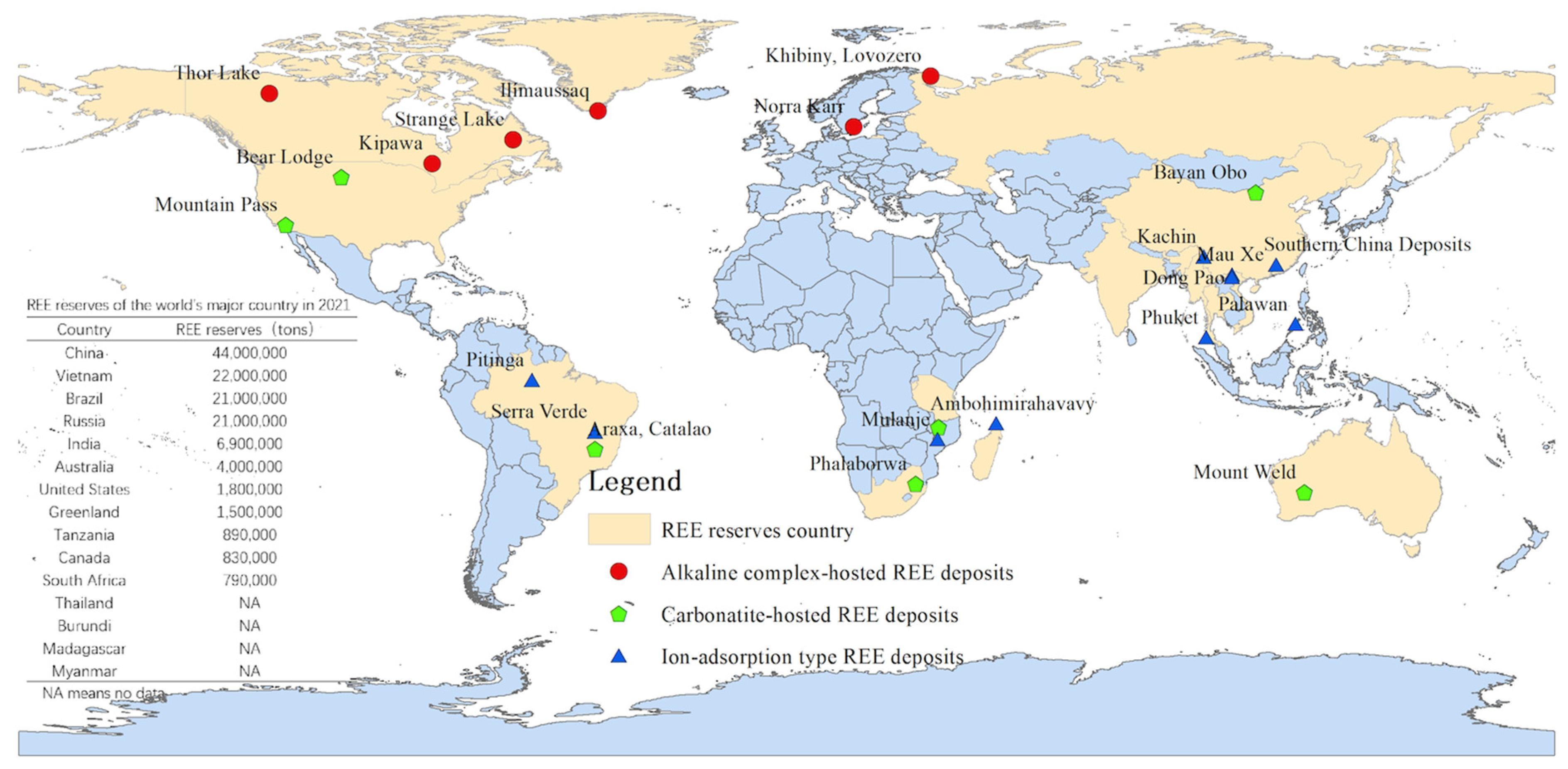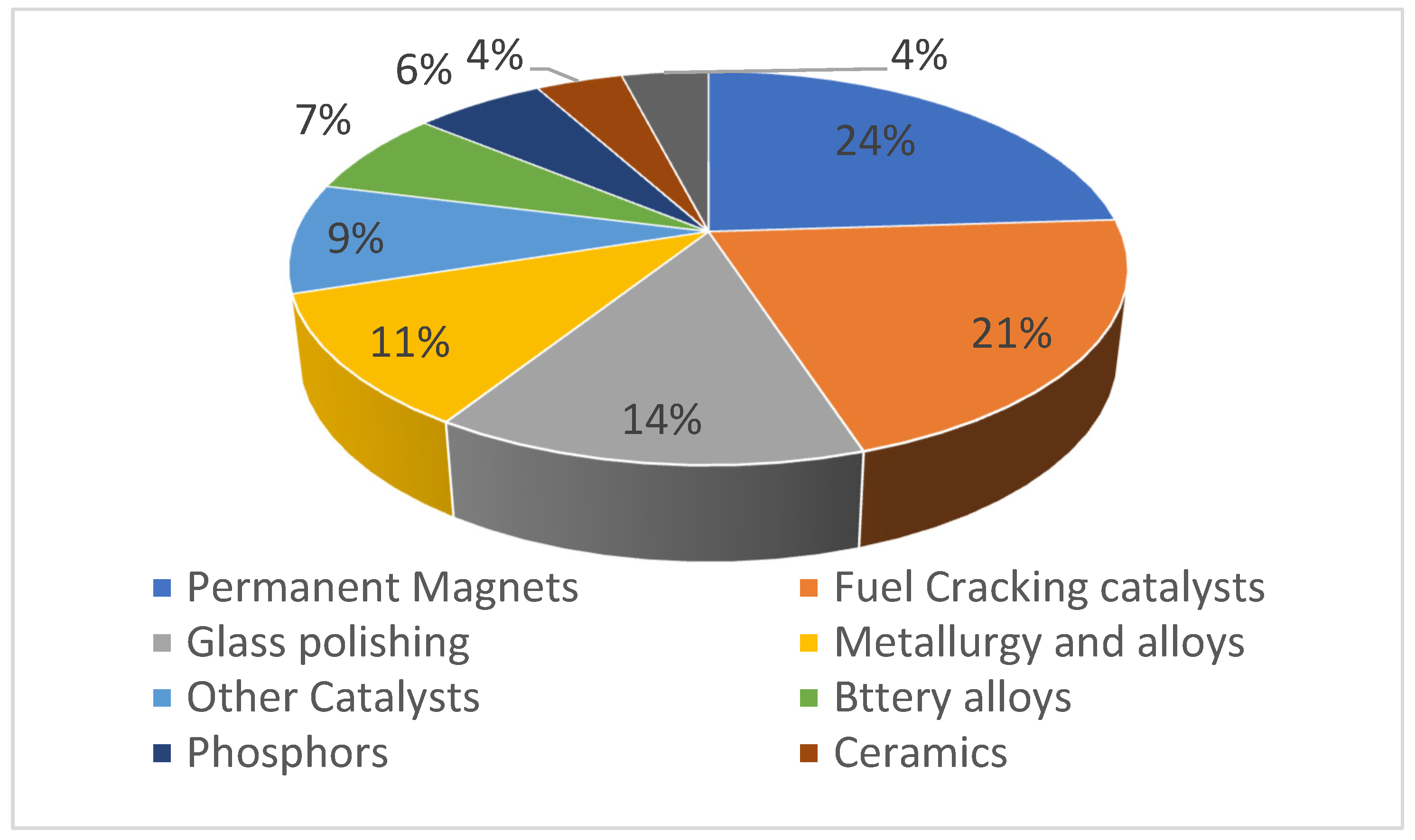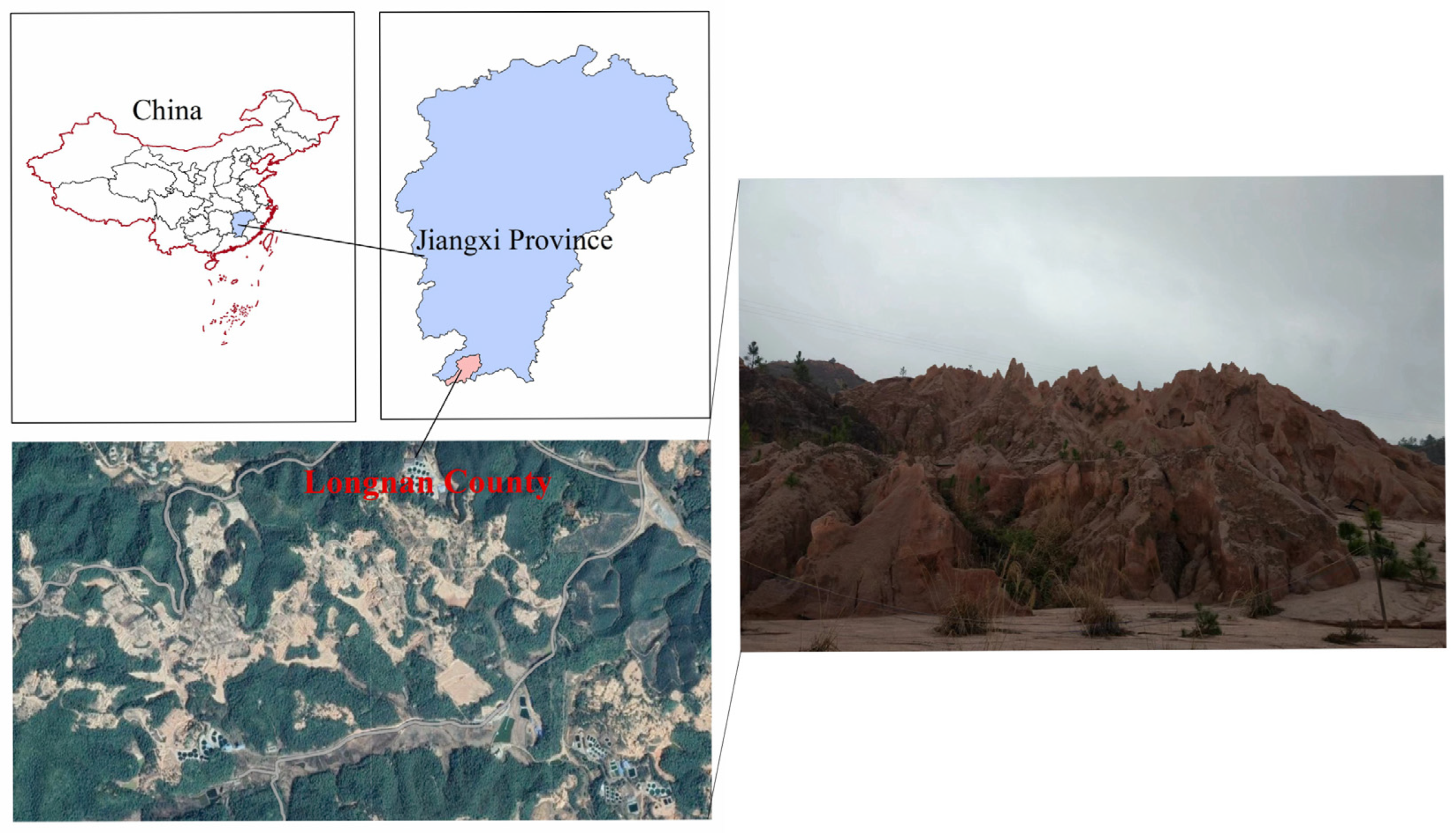Rare earth elements, particularly middle and heavy rare earth, are among the most valuable resources in the pursuit of a greener economy. The production of middle and heavy rare earth elements heavily relies on ion adsorption, which constitutes over 80% of global output and is centered in southern China. Unfortunately, the extensive mining activities have led to severe environmental pollution, resource depletion, and risks to human health.
Rare earth elements, particularly middle and heavy rare earth, are among the most valuable resources in the pursuit of a greener economy. The production of middle and heavy rare earth elements heavily relies on ion adsorption, which constitutes over 80% of global output and is centered in southern China. Unfortunately, the extensive mining activities have led to severe environmental pollution, resource depletion, and risks to human health.
- ion adsorption rare earth
- biochar
- remediation
1. Introduction
1.1. Background
1.2. Ion-Adsorption Type Rare Earths (IAT-Res)

1.3. Usages and Demands

2. Contaminations in IAT-Res Tailings
2.1. Vegetation Loss and Soil Degeneration

2.2. Ammonium Contamination
2.3. REE Contamination
2.4. Current Problems
References
- Balaram, V. Rare Earth Elements: A Review of Applications, Occurrence, Exploration, Analysis, Recycling, and Environmental Impact. Geosci. Front. 2019, 10, 1285–1303.
- Jin, S.; Hu, Z.; Man, B.; Pan, H.; Kong, X.; Jin, D. Application of Phosphate-Containing Materials Affects Bioavailability of Rare Earth Elements and Bacterial Community in Soils. Sci. China Technol. Sci. 2019, 62, 1616–1627.
- International Union of Pure and Applied Chemistry (IUPAC). Nomenclature of Inorganic Chemistry. Chem. Int. Newsmag. IUPAC 2005, 27.
- Gupta, C.K.; Krishnamurthy, N. Extractive Metallurgy of Rare Earths; CRC Press: Boca Raton, FL, USA, 2005; ISBN 978-0-415-33340-5.
- Hu, Z.; Haneklaus, S.; Sparovek, G.; Schnug, E. Rare Earth Elements in Soils. Commun. Soil Sci. Plant Anal. 2006, 37, 1381–1420.
- Jordens, A.; Cheng, Y.P.; Waters, K.E. A Review of the Beneficiation of Rare Earth Element Bearing Minerals. Miner. Eng. 2013, 41, 97–114.
- Zhou, B.; Li, Z.; Chen, C. Global Potential of Rare Earth Resources and Rare Earth Demand from Clean Technologies. Minerals 2017, 7, 203.
- Borst, A.M.; Smith, M.P.; Finch, A.A.; Estrade, G.; Villanova-de-Benavent, C.; Nason, P.; Marquis, E.; Horsburgh, N.J.; Goodenough, K.M.; Xu, C.; et al. Adsorption of Rare Earth Elements in Regolith-Hosted Clay Deposits. Nat. Commun. 2020, 11, 4386.
- Chi, R.; Tian, J.; Li, Z.; Peng, C.; Wu, Y.; Li, S.; Wang, C.; Zhou, Z. Existing State and Partitioning of Rare Earth on Weathered Ores. J. Rare Earths 2005, 23, 756.
- Liu, J.; Wu, X.; Huang, K.; Liu, W.; Zhao, Z.; Liu, H. Instability Behavior of Bubble Supported Organic Liquid Membrane in Extraction of Low-Concentration Rare Earths from in-Situ Leaching Solutions of Ion-Adsorption Ores. Miner. Eng. 2020, 159, 106645.
- Ou, X.; Chen, Z.; Chen, X.; Li, X.; Wang, J.; Ren, T.; Chen, H.; Feng, L.; Wang, Y.; Chen, Z.; et al. Redistribution and Chemical Speciation of Rare Earth Elements in an Ion–Adsorption Rare Earth Tailing, Southern China. Sci. Total Environ. 2022, 821, 153369.
- Xu, Q.; Yang, L.; Wang, D.; Hou, X.; Sun, Y.; Zhou, X.; Zhou, X.; Li, Y. Evaluating the Fractionation of Ion-Adsorption Rare Earths for in-Situ Leaching and Metallogenic Mechanism. J. Rare Earths 2018, 36, 1333–1341.
- Luo, C.; Deng, Y.; Inubushi, K.; Liang, J.; Zhu, S.; Wei, Z.; Guo, X.; Luo, X. Sludge Biochar Amendment and Alfalfa Revegetation Improve Soil Physicochemical Properties and Increase Diversity of Soil Microbes in Soils from a Rare Earth Element Mining Wasteland. Int. J. Environ. Res. Public Health 2018, 15, 965.
- Feng, X.; Onel, O.; Council-Troche, M.; Noble, A.; Yoon, R.-H.; Morris, J.R. A Study of Rare Earth Ion-Adsorption Clays: The Speciation of Rare Earth Elements on Kaolinite at Basic PH. Appl. Clay Sci. 2021, 201, 105920.
- Haque, N.; Hughes, A.; Lim, S.; Vernon, C. Rare Earth Elements: Overview of Mining, Mineralogy, Uses, Sustainability and Environmental Impact. Resources 2014, 3, 614–635.
- Nie, W.; Zhang, R.; He, Z.; Zhou, J.; Wu, M.; Xu, Z.; Chi, R.; Yang, H. Research Progress on Leaching Technology and Theory of Weathered Crust Elution-Deposited Rare Earth Ore. Hydrometallurgy 2020, 193, 105295.
- Yang, X.J.; Lin, A.; Li, X.-L.; Wu, Y.; Zhou, W.; Chen, Z. China’s Ion-Adsorption Rare Earth Resources, Mining Consequences and Preservation. Environ. Dev. 2013, 8, 131–136.
- Kynicky, J.; Smith, M.P.; Xu, C. Diversity of Rare Earth Deposits: The Key Example of China. Elements 2012, 8, 361–367.
- Xiao, Y.; Feng, Z.; Hu, G.; Huang, L.; Huang, X.; Chen, Y.; Long, Z. Reduction Leaching of Rare Earth from Ion-Adsorption Type Rare Earths Ore with Ferrous Sulfate. J. Rare Earths 2016, 34, 917–923.
- Huang, X.-W.; Long, Z.-Q.; Wang, L.-S.; Feng, Z.-Y. Technology Development for Rare Earth Cleaner Hydrometallurgy in China. Rare Met. 2015, 34, 215–222.
- Chen, H.B.; Chen, H.M.; Chen, Z.B.; Chen, Z.Q. The Ecological Impacts of Residues from the Heap Leaching of Ion-Adsorption Rare Earth Clays. Int. J. Environ. Sci. Technol. 2023.
- Mancheri, N.A.; Sprecher, B.; Bailey, G.; Ge, J.; Tukker, A. Effect of Chinese Policies on Rare Earth Supply Chain Resilience. Resour. Conserv. Recycl. 2019, 142, 101–112.
- United States Geological Survey (USGS). Mineral Commodity Summaries; United States Geological Survey (USGS): Reston, VA, USA, 2022; 202p.
- da Costa, T.B.; Silva, M.G.C.d.; Vieira, M.G.A. Recovery of Rare-Earth Metals from Aqueous Solutions by Bio/Adsorption Using Non-Conventional Materials: A Review with Recent Studies and Promising Approaches in Column Applications. J. Rare Earths 2020, 38, 339–355.
- Estrade, G.; Marquis, E.; Smith, M.; Goodenough, K.; Nason, P. REE Concentration Processes in Ion Adsorption Deposits: Evidence from the Ambohimirahavavy Alkaline Complex in Madagascar. Ore Geol. Rev. 2019, 112, 103027.
- Dushyantha, N.; Batapola, N.; Ilankoon, I.M.S.K.; Rohitha, S.; Premasiri, R.; Abeysinghe, B.; Ratnayake, N.; Dissanayake, K. The Story of Rare Earth Elements (REEs): Occurrences, Global Distribution, Genesis, Geology, Mineralogy and Global Production. Ore Geol. Rev. 2020, 122, 103521.
- Goodenough, K.M.; Wall, F.; Merriman, D. The Rare Earth Elements: Demand, Global Resources, and Challenges for Resourcing Future Generations. Nat. Resour. Res. 2018, 27, 201–216.
- Tommasi, F.; Thomas, P.J.; Pagano, G.; Perono, G.A.; Oral, R.; Lyons, D.M.; Toscanesi, M.; Trifuoggi, M. Review of Rare Earth Elements as Fertilizers and Feed Additives: A Knowledge Gap Analysis. Arch. Environ. Contam. Toxicol. 2021, 81, 531–540.
- Anastopoulos, I.; Bhatnagar, A.; Lima, E.C. Adsorption of Rare Earth Metals: A Review of Recent Literature. J. Mol. Liq. 2016, 221, 954–962.
- Asadollahzadeh, M.; Torkaman, R.; Torab-Mostaedi, M. Extraction and Separation of Rare Earth Elements by Adsorption Approaches: Current Status and Future Trends. Sep. Purif. Rev. 2021, 50, 417–444.
- Bailey, G.; Joyce, P.J.; Schrijvers, D.; Schulze, R.; Sylvestre, A.M.; Sprecher, B.; Vahidi, E.; Dewulf, W.; Van Acker, K. Review and New Life Cycle Assessment for Rare Earth Production from Bastnäsite, Ion Adsorption Clays and Lateritic Monazite. Resour. Conserv. Recycl. 2020, 155, 104675.
- Adeel, M.; Lee, J.Y.; Zain, M.; Rizwan, M.; Nawab, A.; Ahmad, M.A.; Shafiq, M.; Yi, H.; Jilani, G.; Javed, R.; et al. Cryptic Footprints of Rare Earth Elements on Natural Resources and Living Organisms. Environ. Int. 2019, 127, 785–800.
- Schreiber, A.; Marx, J.; Zapp, P.; Hake, J.-F.; Voßenkaul, D.; Friedrich, B. Environmental Impacts of Rare Earth Mining and Separation Based on Eudialyte: A New European Way. Resources 2016, 5, 32.
- Liu, L.; Wang, X.; Wen, Q.; Jia, Q.; Liu, Q. Interspecific Associations of Plant Populations in Rare Earth Mining Wasteland in Southern China. Int. Biodeterior. Biodegrad. 2017, 118, 82–88.
- Qiu, T.; Zhu, D.; Fang, X.; Zeng, Q.; Gao, G.; Zhu, H. Leaching Kinetics of Ionic Rare-Earth in Ammonia-Nitrogen Wastewater System Added with Impurity Inhibitors. J. Rare Earths 2014, 32, 1175–1183.
- Chen, H.; Chen, Z.; Chen, Z.; Ou, X.; Chen, J. Calculation of Toxicity Coefficient of Potential Ecological Risk Assessment of Rare Earth Elements. Bull. Environ. Contam. Toxicol. 2020, 104, 582–587.
- Chen, Z. The Biological Hormesis Effects of Rare Earths and Potential Effects of Application of Rare Earths on Agricultural Eco-Environment. Rural Eco-Environ. 2004, 20, 1–5. (In Chinese)
- Li, X.; Chen, Z.; Chen, Z.; Zhang, Y. A Human Health Risk Assessment of Rare Earth Elements in Soil and Vegetables from a Mining Area in Fujian Province, Southeast China. Chemosphere 2013, 93, 1240–1246.
- Gao, Z.; Zhou, Q. Contamination from Rare Earth Ore Strip Mining and Its Impacts on Resources and Ecovironment. Chin. J. Ecol. 2011, 30, 2915–2922. (In Chinese)
- Chen, Z.; Chen, Z. Effects of Ecological Restoration Measures on the Distribution of Dicranopteris Dichotoma at the Microscale in the Red Soil Hilly Region of China. PLoS ONE 2018, 13, e0204743.
- Ou, Z.; Pang, S.; He, Q.; Peng, Y.; Huang, X.; Shen, W. Effects of Vegetation Restoration and Environmental Factors on Understory Vascular Plants in a Typical Karst Ecosystem in Southern China. Sci. Rep. 2020, 10, 12011.
- Szamałek, K.; Konopka, G.; Zglinicki, K.; Marciniak-Maliszewska, B. New Potential Source of Rare Earth Elements. Gospod. Surowcami Min. 2013, 29, 59–76.
- Chen, S.; Zha, X.; Bai, Y.; Wang, L. Evaluation of Soil Erosion Vulnerability on the Basis of Exposure, Sensitivity, and Adaptive Capacity: A Case Study in the Zhuxi Watershed, Changting, Fujian Province, Southern China. Catena 2019, 177, 57–69.
- Wen, X.; Duan, C.; Zhang, D. Effect of Simulated Acid Rain on Soil Acidification and Rare Earth Elements Leaching Loss in Soils of Rare Earth Mining Area in Southern Jiangxi Province of China. Environ. Earth Sci. 2013, 69, 843–853.
- Yang, L.; Wang, D.; Li, C.; Sun, Y.; Zhou, X.; Li, Y. Searching High Efficiency and Environmentally Benign Leaching Reagent for Ion-Adsorption Rare Earth Based on the Zeta Potential of Clay Particles. Green Chem. 2016, 18, 1839–1854.
- Xiao, Y.; Chen, Y.; Feng, Z.; Huang, X.; Huang, L.; Long, Z.; Cui, D. Leaching Characteristics of Ion-Adsorption Type Rare Earths Ore with Magnesium Sulfate. Trans. Nonferrous Met. Soc. China 2015, 25, 3784–3790.
- Zhang, Q.; Ren, F.; Li, F.; Chen, G.; Yang, G.; Wang, J.; Du, K.; Liu, S.; Li, Z. Ammonia Nitrogen Sources and Pollution along Soil Profiles in an In-Situ Leaching Rare Earth Ore. Environ. Pollut. 2020, 267, 115449.
- GB 26451-2011; China Rare Earth Emission Standards of Pollutants from Rare Earths Industry. National Standard of the People’s Republic of China: Beijing, China, 2011. Available online: https://std.samr.gov.cn/gb/search/gbDetailed?id=71F772D7DFD1D3A7E05397BE0A0AB82A (accessed on 8 May 2023). (In Chinese)
- Hao, X.; Wang, D.; Wang, P.; Wang, Y.; Zhou, D. Evaluation of Water Quality in Surface Water and Shallow Groundwater: A Case Study of a Rare Earth Mining Area in Southern Jiangxi Province, China. Environ. Monit. Assess. 2016, 188, 24.
- Zhang, Q.; Wan, G.; Zhou, C.; Luo, J.; Lin, J.; Zhao, X. Rehabilitation Effect of the Combined Application of Bamboo Biochar and Coal Ash on Ion-Adsorption-Type Rare Earth Tailings. J. Soils Sediments 2020, 20, 3351–3357.
- Chao, Y.; Liu, W.; Chen, Y.; Chen, W.; Zhao, L.; Ding, Q.; Wang, S.; Tang, Y.-T.; Zhang, T.; Qiu, R.-L. Structure, Variation, and Co-Occurrence of Soil Microbial Communities in Abandoned Sites of a Rare Earth Elements Mine. Environ. Sci. Technol. 2016, 50, 11481–11490.
- Liu, W.-S.; Guo, M.-N.; Liu, C.; Yuan, M.; Chen, X.-T.; Huot, H.; Zhao, C.-M.; Tang, Y.-T.; Morel, J.L.; Qiu, R.-L. Water, Sediment and Agricultural Soil Contamination from an Ion-Adsorption Rare Earth Mining Area. Chemosphere 2019, 216, 75–83.
- Ding, J.; Deng, G. Main Problems in the Current Ionic Adsorption Rare Earth Exploration Specifications and Their Amendment Proposals. Nonferrous Met. Sci. Eng. 2013, 4, 96–102. (In Chinese)
- Chen, H.; Chen, Z.; Chen, Z.; Ma, Q.; Zhang, Q. Rare Earth Elements in Paddy Fields from Eroded Granite Hilly Land in a Southern China Watershed. PLoS ONE 2019, 14, e0222330.
- Martinez, R.E.; Pourret, O.; Faucon, M.-P.; Dian, C. Effect of Rare Earth Elements on Rice Plant Growth. Chem. Geol. 2018, 489, 28–37.
- Pagano, G.; Guida, M.; Tommasi, F.; Oral, R. Health Effects and Toxicity Mechanisms of Rare Earth Elements—Knowledge Gaps and Research Prospects. Ecotoxicol. Environ. Saf. 2015, 115, 40–48.
- Thomas, P.J.; Carpenter, D.; Boutin, C.; Allison, J.E. Rare Earth Elements (REEs): Effects on Germination and Growth of Selected Crop and Native Plant Species. Chemosphere 2014, 96, 57–66.
- British Geological Survey. An Update to the Supply Risk Index for Elements or Element Groups That Are of Economic Value; British Geological Survey: Nottingham, UK, 2015. Available online: https://www2.bgs.ac.uk/mineralsuk/download/statistics/risk_list_2015.pdf (accessed on 8 May 2023).
- European Commission. Critical Raw Materials Resilience: Charting a Path towards Greater Security and Sustainability; Communication from the Commission to the European Parliament, the Council, the European Economic and Social Committee and the Committee of the Regions. Brussels, 3.9.2020 COM(2020) 474 Final. Available online: https://eur-lex.europa.eu/legal-content/EN/TXT/PDF/?uri=CELEX:52020DC0474 (accessed on 8 May 2023).
